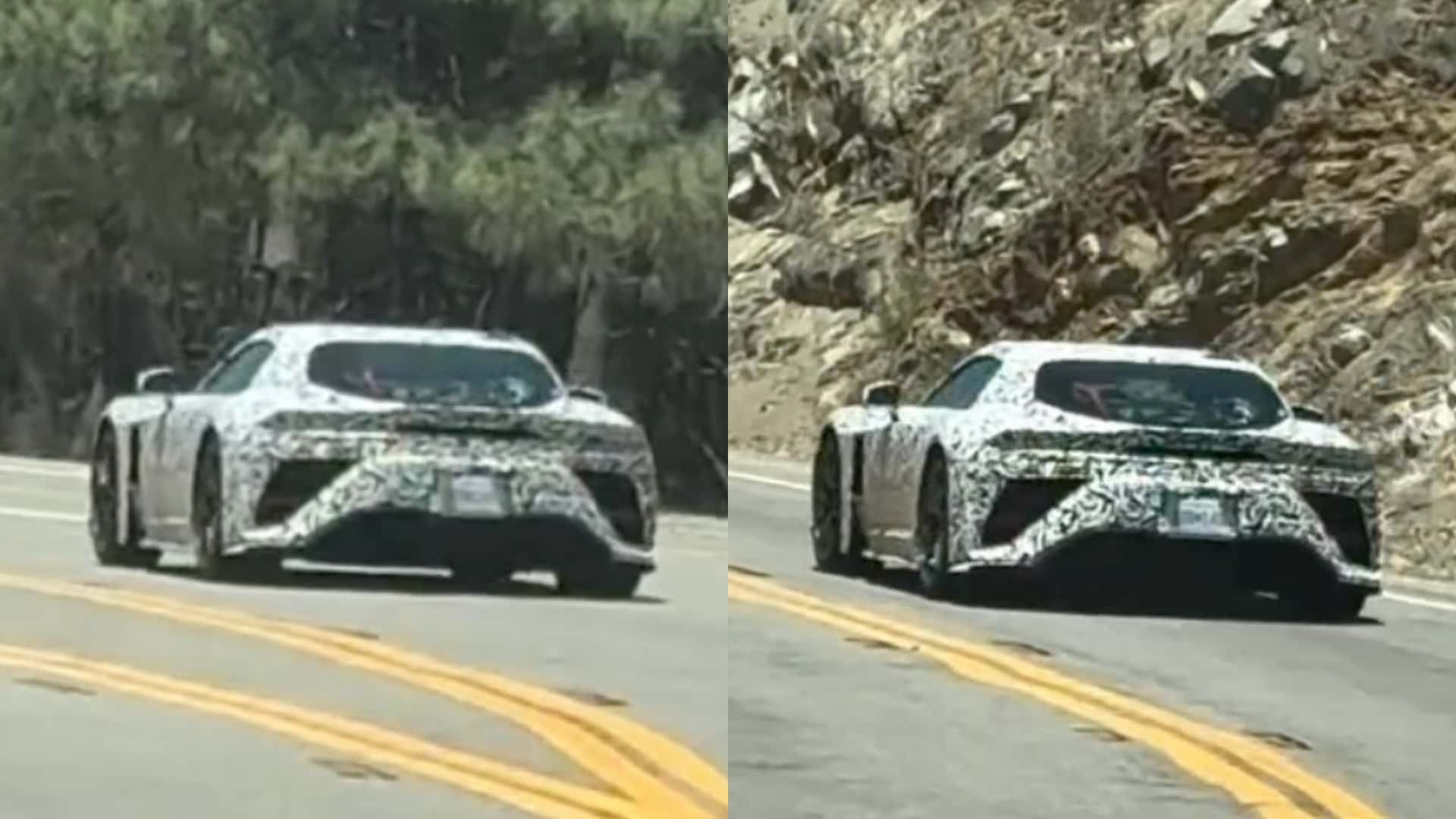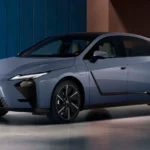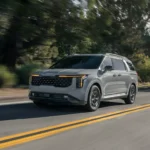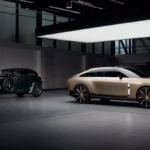The automotive world is buzzing with excitement as Lexus inches closer to unveiling the spiritual successor to its legendary LFA supercar. This highly anticipated vehicle has recently been spotted undergoing rigorous public road testing, offering enthusiasts the latest glimpse into its advanced design and potential powertrain.
While its official name remains a mystery, strong rumors suggest it could be christened the LFR, a moniker that would fittingly connect it to its iconic predecessor. This new, low-slung coupe is expected to redefine Lexus’s performance aspirations, combining cutting-edge technology with exhilarating power.
The upcoming discontinuation of the Lexus RC after this year will temporarily leave the brand without a dedicated sports car in its lineup. However, this gap is unlikely to last long. These recent spy photos confirm that the racy two-door coupe is progressing rapidly towards full production. Crucially, in an era increasingly dominated by electric vehicles, this next Lexus supercar will proudly feature a gas-powered engine, thrilling purists and performance enthusiasts alike.
This commitment to internal combustion, likely coupled with hybrid technology, positions the LFA successor as a compelling blend of traditional automotive passion and modern efficiency.
First Glimpse: Southern California Spy Shots
New spy photographs offer an exclusive look at the LFA successor, revealing key design elements and confirming its powerful internal-combustion heart.
Camouflaged Beast on Mountain Roads
A fortunate Car and Driver reader named Kory Hughs provided an invaluable peek at the new Lexus supercar. Hughs captured several striking photographs of the vehicle, heavily cloaked in camouflage, as it navigated the scenic and challenging mountain roads near Big Bear Lake, California. These images, while carefully obscuring much of the car’s intricate design, offer concrete evidence of its physical presence and ongoing development. The camouflaged prototype was seen in motion, highlighting its dynamic capabilities even in its testing phase.
The new photos primarily showcase the driver’s side and the rear end of the car. Despite the concealment, one critical detail is clearly visible: the presence of quad exhaust pipes. This feature definitively confirms the existence of an internal-combustion engine nestled beneath the rakish coupe’s elongated hood.
This is a significant revelation, as many modern high-performance vehicles are shifting towards full electrification. The quad exhaust setup suggests a powerful engine configuration, promising a visceral auditory experience to match its performance. While Lexus has yet to officially confirm the precise details, the powertrain is widely expected to combine a hybrid system with a twin-turbo V-8. This configuration would leverage both raw power and modern efficiency, potentially delivering astonishing performance figures.
Design Cues and Performance Hints
Beyond the unmistakable quad exhaust, the recent spy shots, though limited, provide hints about the overall design and performance philosophy of the forthcoming Lexus supercar. The term “low-slung coupe” accurately describes its profile, suggesting a vehicle engineered for optimal aerodynamics and a low center of gravity.
This design choice is typical of high-performance sports cars, maximizing stability and handling capabilities at high speeds. The “long hood” further implies a front-engine, rear-wheel-drive or all-wheel-drive layout, characteristic of many traditional grand tourers and supercars.
The presence of a twin-turbo V-8 engine signifies a dedication to immense power output, a crucial element for a true supercar. The “twin-turbo” aspect suggests forced induction, which typically allows for greater horsepower and torque from a smaller displacement engine, compared to naturally aspirated counterparts. Incorporating a hybrid system would likely provide instant torque fill, enhancing acceleration from a standstill, and potentially offer a boost in overall horsepower.
It might also allow for short bursts of electric-only driving, contributing to efficiency or quiet operation when desired. The very fact that this highly camouflaged prototype is being tested on public roads, specifically in challenging mountain environments, indicates that Lexus is thoroughly refining its dynamics and real-world performance. This public testing phase is a critical step before a production model can be finalized, ensuring the vehicle meets rigorous performance and reliability standards.
Previous Sightings and Racing Connections
This isn’t the first time the LFA successor has been spotted, with earlier sightings at the Nürburgring revealing more about its development and racing aspirations.
Nürburgring Testing and Hybrid Clues
The latest spy photos from Southern California are not the inaugural sightings of the LFA follow-up. Previously, prototypes of this highly anticipated supercar were observed undergoing intensive testing at and around the legendary Nürburgring racetrack in Germany.
The Nürburgring Nordschleife, often referred to as “The Green Hell,” is a notoriously demanding circuit, making it an ideal proving ground for high-performance vehicles. The cars testing there displayed interesting variations, particularly in their rear wing configurations. Unlike the recently spied car in California, some of the Nürburgring prototypes utilized “different types of fixed rear wings.” This suggests Lexus is experimenting with various aerodynamic packages, potentially for different performance trims or for balancing downforce with drag.
Furthermore, the Nürburgring test cars bore distinct yellow warning stickers. These stickers are commonly used in the automotive industry to indicate the presence of electric power in addition to a combustion engine, effectively confirming a hybrid powertrain. This detail aligns with the current rumors regarding a twin-turbo V-8 hybrid setup.
During these earlier tests, spy photographers also managed to capture images of the car’s unfinished interior, providing a rare glimpse into the cockpit’s development. Perhaps most tantalizingly, the spy photographer claimed that these prototypes were lapping the ‘Ring in under eight minutes. This would place the LFA successor in an elite category of performance cars, demonstrating its formidable track capabilities even in its developmental stages.
Toyota Gazoo Racing and GT3 Homologation
The development of the Lexus LFA successor is believed to be closely intertwined with Toyota’s Gazoo Racing (GR) division. GR is the performance and motorsport arm of Toyota, renowned for its successful racing programs and enthusiast-focused road cars. There’s a strong belief that Gazoo Racing is actively working on building a new GT3 car for a full-fledged racing program.
This racing endeavor was hinted at back in 2022 with a concept car that bears a striking resemblance to the forthcoming road-going Lexus supercar. This suggests that the road car, potentially named LFR, could serve as a homologation special for a racing variant, meaning the street-legal version is developed directly from a race car platform to meet specific racing regulations.
This strategic approach would ensure the road car benefits from race-proven technology, maximizing its performance and handling characteristics. The very fact that a prototype is now testing on public roads signifies that the project is nearing its final stages of development. Public road testing allows engineers to fine-tune the car’s behavior in real-world conditions, addressing factors like ride comfort, noise, vibration, and harshness (NVH), as well as drivability in various traffic scenarios.
Given these advanced stages of testing, enthusiasts can anticipate learning more about the LFA’s replacement sometime next year. Based on the typical automotive development cycles and release schedules, industry experts “think the production version could possibly debut for the 2027 model year.” This timeline would allow Lexus to thoroughly refine the vehicle, build anticipation, and execute a impactful global launch for what promises to be a groundbreaking addition to the supercar segment.
The Powertrain: A Hybrid V-8 Confirmation
The latest sightings and previous reports collectively paint a clearer picture of the LFA successor’s sophisticated and powerful powertrain.
Twin-Turbo V-8 with Electrification
The most consistent and exciting rumor surrounding the Lexus LFA successor’s powertrain points towards a sophisticated hybrid system combined with a twin-turbo V-8 engine. The recent spy shots, revealing the distinctive quad exhaust pipes, provide compelling visual evidence of the internal combustion component.
This setup is a significant departure from the original LFA’s naturally aspirated V10, reflecting modern engineering trends towards forced induction and electrification for both performance and efficiency. A twin-turbo V-8 typically offers immense power output and torque, often surpassing naturally aspirated engines of larger displacement. The “twin-turbo” configuration helps minimize turbo lag, ensuring responsive acceleration across the rev range.
The integration of a hybrid system would further enhance performance. Electric motors can provide instant torque from zero RPM, filling in any power gaps before the turbochargers spool up, resulting in blistering acceleration. This also allows for features like silent electric-only driving at low speeds, reducing emissions in urban environments.
While specific power figures are not yet confirmed by Lexus, industry speculation, often citing sources close to Toyota’s Gazoo Racing division, suggests a combined output that could well push the vehicle into the upper echelons of supercar performance, potentially exceeding 900 horsepower. This advanced powertrain configuration indicates Lexus’s commitment to delivering a truly competitive and technologically forward-thinking supercar.
Balancing Performance and Modern Demands
The choice of a hybrid twin-turbo V-8 for the Lexus LFA successor demonstrates a strategic approach to balancing exhilarating performance with contemporary automotive demands. In today’s stringent regulatory environment, simply relying on a large, naturally aspirated engine, as with the original LFA, has become increasingly challenging due to emissions standards and fuel efficiency requirements.
The hybrid component allows Lexus to comply with these regulations while simultaneously boosting performance. Electric motors can recover energy during braking and coasting, which is then redeployed for acceleration, effectively providing a “boost” function.
Furthermore, this powertrain aligns with Lexus’s broader electrification strategy. While the LFA successor will retain a powerful internal combustion engine, its hybrid nature positions it as a bridge towards a more electrified future for high-performance vehicles. This allows Lexus to cater to enthusiasts who still crave the sound and feel of a powerful gasoline engine, while also showcasing their technological prowess in hybrid systems.
The meticulous testing on both public roads and demanding racetracks like the Nürburgring signifies that Lexus is dedicated to optimizing every aspect of this powertrain, ensuring it delivers not only impressive numbers but also a refined, engaging, and dynamically superior driving experience that lives up to the legacy of the LFA.
The Future of Lexus Sports Cars
With the LFA successor nearing production, Lexus is poised to re-establish its presence in the high-performance sports car segment, filling a void left by outgoing models.
Filling the Void of the RC
The impending end of production for the Lexus RC marks a temporary absence of a dedicated sports car in Lexus’s lineup. The RC, while a capable coupe, has been on the market for some time and doesn’t quite sit in the same performance stratosphere as the original LFA or its upcoming successor. Its departure creates a significant void for Lexus enthusiasts and for the brand’s image as a producer of exciting, driver-focused vehicles. The arrival of the LFA successor, potentially as early as the 2027 model year, is perfectly timed to fill this gap.
This new supercar isn’t just a replacement; it’s an elevation. It’s designed to be a halo car, showcasing Lexus’s peak engineering capabilities and pushing the boundaries of performance and luxury. Its presence will immediately inject a jolt of excitement back into the brand’s portfolio, attracting attention and reaffirming Lexus’s commitment to high-performance vehicles. While the RC catered to a broader sports coupe audience, the LFA successor aims squarely at the elite supercar segment, promising an exclusive and exhilarating driving experience that will once again place Lexus among the world’s most desirable performance car manufacturers.
Anticipated Debut and Market Impact
The widespread public road testing of the Lexus LFA successor indicates that its official reveal is drawing near. With prototypes now visible in everyday environments, it’s highly probable that Lexus will release more official details sometime next year. This gradual unveiling of information, following previous spy shots from the Nürburgring, builds anticipation and allows the brand to control the narrative around its new flagship performance model. Industry speculation points to a potential production debut for the 2027 model year. This timeline provides Lexus with ample opportunity to finalize testing, establish production lines, and strategize a global marketing campaign befitting a car of this caliber.
When it finally arrives, the LFA successor is expected to make a significant impact on the supercar market. Its blend of a powerful twin-turbo V-8, hybrid technology, and a design philosophy rooted in both racing and luxury will position it as a formidable competitor to established European rivals.
The original LFA gained legendary status not just for its performance but also for its unique character and the sheer audacity of its engineering. The forthcoming model aims to carry that torch, demonstrating Lexus’s continued ability to innovate and captivate. Its success will undoubtedly elevate the entire Lexus brand, reaffirming its position as a serious contender in the luxury and performance automotive segments for years to come.
Lexus’s Bold Step Forward
The recent spy sightings of Lexus’s LFA successor, likely to be named the LFR, confirm that this highly anticipated supercar is rapidly nearing production. From its low-slung, camouflaged form spotted on California’s mountain roads to its quad exhaust pipes hinting at a powerful internal combustion engine, every detail points to a vehicle designed for uncompromising performance. The widely rumored twin-turbo V-8 hybrid powertrain further solidifies its position as a technological marvel, balancing raw power with modern efficiency.
With previous rigorous testing at the Nürburgring, including reported sub-eight-minute lap times, and its strong ties to Toyota’s Gazoo Racing GT3 program, the LFR is clearly being engineered with motorsport pedigree at its core. This strategic development will allow Lexus to fill the void left by the outgoing RC and firmly re-establish its presence in the elite sports car segment.
As the 2027 model year approaches, enthusiasts worldwide eagerly await the official unveiling of what promises to be a groundbreaking and exhilarating addition to the world of supercars.






